 Backend Development
Backend Development
 Python Tutorial
Python Tutorial
 Using Python to implement a simple four arithmetic interpreter
Using Python to implement a simple four arithmetic interpreter
Using Python to implement a simple four arithmetic interpreter
Calculation function demonstration
Here we first show the help information of the program, and then a few simple four arithmetic operations tests. It seems that there is no problem (I cannot guarantee that the program has no bugs!).
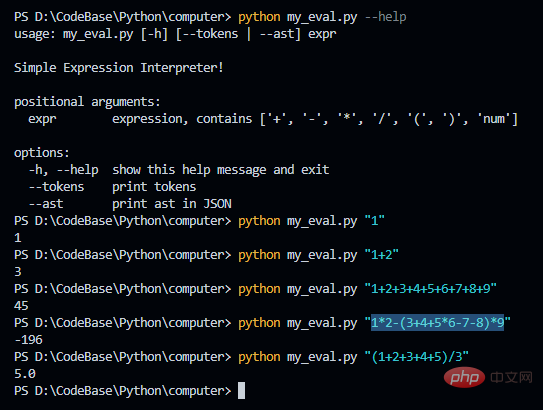
Output tokens
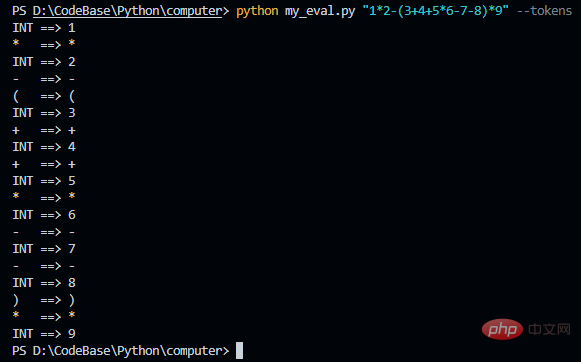
Output AST
This formatted JSON message is too long. Not conducive to direct viewing. We render it to see the final generated tree diagram (see the previous two blogs for methods). Save the following JSON in a file, here I call it demo.json, and then execute the following command: pytm-cli -d LR -i demo.json -o demo.html, and then open the generated file in the browser html file.
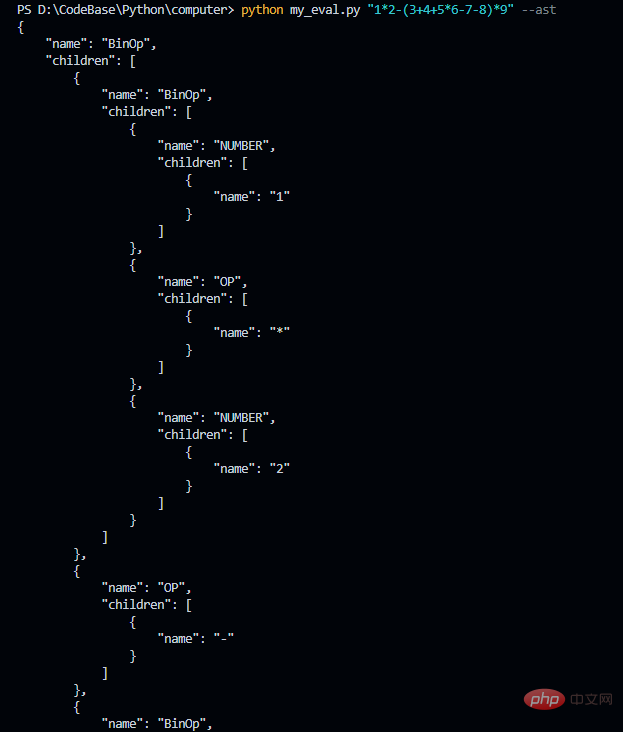
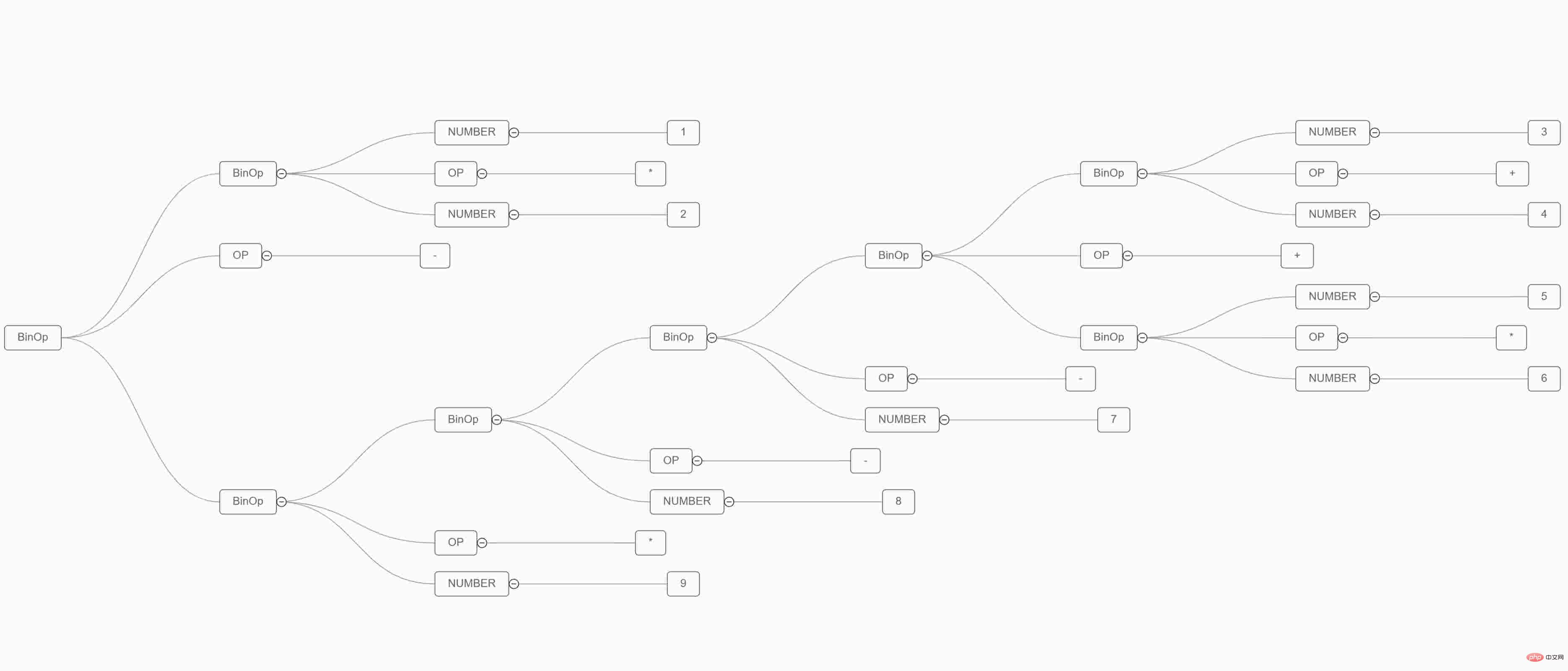
my_eval.py, if you want to run it, copy and paste, and then follow the steps of the demonstration.
The lexizer method in Calculator is used for word segmentation. Originally, I planned to use regularization. If you have read my previous blog, you can I found that I used regular expressions to segment words (because there is a simple word segmentation program in the regular expressions of Python's official documentation). But I saw that other people were writing participles by hand, so I did the same, but it didn’t feel very good, it was very tedious and error-prone.
The parse method is for parsing, mainly to analyze the structure of the expression, determine whether it conforms to the grammar of the four arithmetic operations, and finally generate the expression tree (its AST).
"""
Grammar
G -> E
E -> T E'
E' -> '+' T E' | '-' T E' | ɛ
T -> F T'
T' -> '*' F T' | '/' F T' | ɛ
F -> '(' E ')' | num | name
"""
import json
import argparse
class Node:
"""
简单的抽象语法树节点,定义一些需要使用到的具有层次结构的节点
"""
def eval(self) -> float: ... # 节点的计算方法
def visit(self): ... # 节点的访问方法
class BinOp(Node):
"""
BinOp Node
"""
def __init__(self, left, op, right) -> None:
self.left = left
self.op = op
self.right = right
def eval(self) -> float:
if self.op == "+":
return self.left.eval() + self.right.eval()
if self.op == "-":
return self.left.eval() - self.right.eval()
if self.op == "*":
return self.left.eval() * self.right.eval()
if self.op == "/":
return self.left.eval() / self.right.eval()
return 0
def visit(self):
"""
遍历树的各个节点,并生成 JSON 表示
"""
return {
"name": "BinOp",
"children": [
self.left.visit(),
{
"name": "OP",
"children": [
{
"name": self.op
}
]
},
self.right.visit()
]
}
class Constant(Node):
"""
Constant Node
"""
def __init__(self, value) -> None:
self.value = value
def eval(self) -> float:
return self.value
def visit(self):
return {
"name": "NUMBER",
"children": [
{
"name": str(self.value) # 转成字符是因为渲染成图像时,需要该字段为 str
}
]
}
class Calculator:
"""
Simple Expression Parser
"""
def __init__(self, expr) -> None:
self.expr = expr # 输入的表达式
self.parse_end = False # 解析是否结束,默认未结束
self.toks = [] # 解析的 tokens
self.index = 0 # 解析的下标
def lexizer(self):
"""
分词
"""
index = 0
while index < len(self.expr):
ch = self.expr[index]
if ch in [" ", "\r", "\n"]:
index += 1
continue
if '0' <= ch <= '9':
num_str = ch
index += 1
while index < len(self.expr):
n = self.expr[index]
if '0' <= n <= '9':
if ch == '0':
raise Exception("Invalid number!")
num_str = n
index += 1
continue
break
self.toks.append({
"kind": "INT",
"value": int(num_str)
})
elif ch in ['+', '-', '*', '/', '(', ')']:
self.toks.append({
"kind": ch,
"value": ch
})
index += 1
else:
raise Exception("Unkonwn character!")
def get_token(self):
"""
获取当前位置的 token
"""
if 0 <= self.index < len(self.toks):
tok = self.toks[self.index]
return tok
if self.index == len(self.toks): # token解析结束
return {
"kind": "EOF",
"value": "EOF"
}
raise Exception("Encounter Error, invalid index = ", self.index)
def move_token(self):
"""
下标向后移动一位
"""
self.index += 1
def parse(self) -> Node:
"""
G -> E
"""
# 分词
self.lexizer()
# 解析
expr_tree = self.parse_expr()
if self.parse_end:
return expr_tree
else:
raise Exception("Invalid expression!")
def parse_expr(self):
"""
E -> T E'
E' -> + T E' | - T E' | ɛ
"""
# E -> E E'
left = self.parse_term()
# E' -> + T E' | - T E' | ɛ
while True:
tok = self.get_token()
kind = tok["kind"]
value = tok["value"]
if tok["kind"] == "EOF":
# 解析结束的标志
self.parse_end = True
break
if kind in ["+", "-"]:
self.move_token()
left = BinOp(left, value, self.parse_term())
else:
break
return left
def parse_term(self):
"""
T -> F T'
T' -> * F T' | / F T' | ɛ
"""
# T -> F T'
left = self.parse_factor()
# T' -> * F T' | / F T' | ɛ
while True:
tok = self.get_token()
kind = tok["kind"]
value = tok["value"]
if kind in ["*", "/"]:
self.move_token()
right = self.parse_factor()
left = BinOp(left, value, right)
else:
break
return left
def parse_factor(self):
"""
F -> '(' E ')' | num | name
"""
tok = self.get_token()
kind = tok["kind"]
value = tok["value"]
if kind == '(':
self.move_token()
expr_node = self.parse_expr()
if self.get_token()["kind"] != ")":
raise Exception("Encounter Error, expected )!")
self.move_token()
return expr_node
if kind == "INT":
self.move_token()
return Constant(value=value)
raise Exception("Encounter Error, unknown factor: ", kind)
if __name__ == "__main__":
# 添加命令行参数解析器
cmd_parser = argparse.ArgumentParser(
description="Simple Expression Interpreter!")
group = cmd_parser.add_mutually_exclusive_group()
group.add_argument("--tokens", help="print tokens", action="store_true")
group.add_argument("--ast", help="print ast in JSON", action="store_true")
cmd_parser.add_argument(
"expr", help="expression, contains ['+', '-', '*', '/', '(', ')', 'num']")
args = cmd_parser.parse_args()
calculator = Calculator(expr=args.expr)
tree = calculator.parse()
if args.tokens: # 输出 tokens
for t in calculator.toks:
print(f"{t['kind']:3s} ==> {t['value']}")
elif args.ast: # 输出 JSON 表示的 AST
print(json.dumps(tree.visit(), indent=4))
else: # 计算结果
print(tree.eval())my_eval.py, but I feel that there are not many people behind it, so I will say it here. If you write a complex expression, how do you verify whether it is correct? Here we can just use Python, the most perfect interpreter, haha. Python's eval function is used here. Of course, you don't need to call this function, just copy the calculated expression directly. I use the eval function just to express why my program is called my_eval.
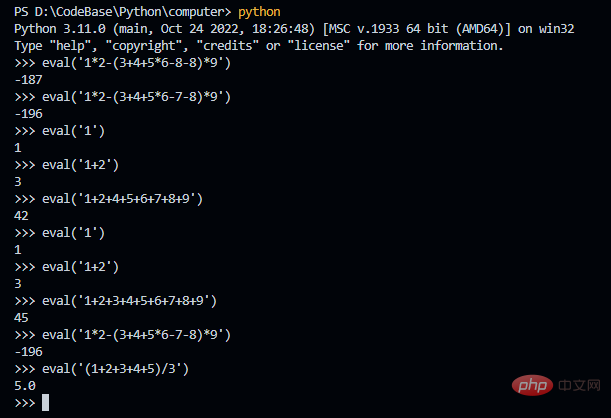
The above is the detailed content of Using Python to implement a simple four arithmetic interpreter. For more information, please follow other related articles on the PHP Chinese website!

Hot AI Tools

Undresser.AI Undress
AI-powered app for creating realistic nude photos

AI Clothes Remover
Online AI tool for removing clothes from photos.

Undress AI Tool
Undress images for free

Clothoff.io
AI clothes remover

Video Face Swap
Swap faces in any video effortlessly with our completely free AI face swap tool!

Hot Article

Hot Tools

Notepad++7.3.1
Easy-to-use and free code editor

SublimeText3 Chinese version
Chinese version, very easy to use

Zend Studio 13.0.1
Powerful PHP integrated development environment

Dreamweaver CS6
Visual web development tools

SublimeText3 Mac version
God-level code editing software (SublimeText3)

Hot Topics
 PHP and Python: Different Paradigms Explained
Apr 18, 2025 am 12:26 AM
PHP and Python: Different Paradigms Explained
Apr 18, 2025 am 12:26 AM
PHP is mainly procedural programming, but also supports object-oriented programming (OOP); Python supports a variety of paradigms, including OOP, functional and procedural programming. PHP is suitable for web development, and Python is suitable for a variety of applications such as data analysis and machine learning.
 Choosing Between PHP and Python: A Guide
Apr 18, 2025 am 12:24 AM
Choosing Between PHP and Python: A Guide
Apr 18, 2025 am 12:24 AM
PHP is suitable for web development and rapid prototyping, and Python is suitable for data science and machine learning. 1.PHP is used for dynamic web development, with simple syntax and suitable for rapid development. 2. Python has concise syntax, is suitable for multiple fields, and has a strong library ecosystem.
 Python vs. JavaScript: The Learning Curve and Ease of Use
Apr 16, 2025 am 12:12 AM
Python vs. JavaScript: The Learning Curve and Ease of Use
Apr 16, 2025 am 12:12 AM
Python is more suitable for beginners, with a smooth learning curve and concise syntax; JavaScript is suitable for front-end development, with a steep learning curve and flexible syntax. 1. Python syntax is intuitive and suitable for data science and back-end development. 2. JavaScript is flexible and widely used in front-end and server-side programming.
 PHP and Python: A Deep Dive into Their History
Apr 18, 2025 am 12:25 AM
PHP and Python: A Deep Dive into Their History
Apr 18, 2025 am 12:25 AM
PHP originated in 1994 and was developed by RasmusLerdorf. It was originally used to track website visitors and gradually evolved into a server-side scripting language and was widely used in web development. Python was developed by Guidovan Rossum in the late 1980s and was first released in 1991. It emphasizes code readability and simplicity, and is suitable for scientific computing, data analysis and other fields.
 Can vs code run in Windows 8
Apr 15, 2025 pm 07:24 PM
Can vs code run in Windows 8
Apr 15, 2025 pm 07:24 PM
VS Code can run on Windows 8, but the experience may not be great. First make sure the system has been updated to the latest patch, then download the VS Code installation package that matches the system architecture and install it as prompted. After installation, be aware that some extensions may be incompatible with Windows 8 and need to look for alternative extensions or use newer Windows systems in a virtual machine. Install the necessary extensions to check whether they work properly. Although VS Code is feasible on Windows 8, it is recommended to upgrade to a newer Windows system for a better development experience and security.
 Can visual studio code be used in python
Apr 15, 2025 pm 08:18 PM
Can visual studio code be used in python
Apr 15, 2025 pm 08:18 PM
VS Code can be used to write Python and provides many features that make it an ideal tool for developing Python applications. It allows users to: install Python extensions to get functions such as code completion, syntax highlighting, and debugging. Use the debugger to track code step by step, find and fix errors. Integrate Git for version control. Use code formatting tools to maintain code consistency. Use the Linting tool to spot potential problems ahead of time.
 How to run python with notepad
Apr 16, 2025 pm 07:33 PM
How to run python with notepad
Apr 16, 2025 pm 07:33 PM
Running Python code in Notepad requires the Python executable and NppExec plug-in to be installed. After installing Python and adding PATH to it, configure the command "python" and the parameter "{CURRENT_DIRECTORY}{FILE_NAME}" in the NppExec plug-in to run Python code in Notepad through the shortcut key "F6".
 Is the vscode extension malicious?
Apr 15, 2025 pm 07:57 PM
Is the vscode extension malicious?
Apr 15, 2025 pm 07:57 PM
VS Code extensions pose malicious risks, such as hiding malicious code, exploiting vulnerabilities, and masturbating as legitimate extensions. Methods to identify malicious extensions include: checking publishers, reading comments, checking code, and installing with caution. Security measures also include: security awareness, good habits, regular updates and antivirus software.





